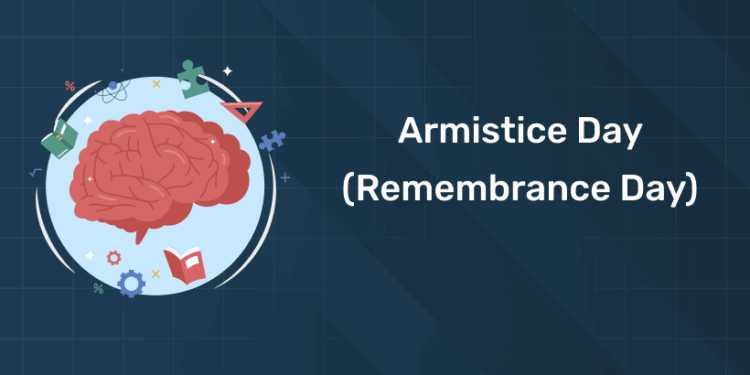Table of Contents
Remembrance Day 2025 in India will be celebrated on 11th November in order to remember the members of the armed forces who have died in the line of duty. It is a memorial day that is observed in every part of the world in order to remember the honoured armed forces and the police officers who died in action to save the country from terrorists. Given below we are sharing some of the most important specifications related to remembrance day 2025 and the significance of the celebration of this day in different parts of the world.
Armistice Day (Remembrance Day) 2025 Date – November 11
In this article readers can get a glimpse on
- Objective and Significance of Armistice Day (Remembrance Day)
- Armistice Day (Remembrance Day) Theme 2025
- Armistice Day (Remembrance Day) Quiz
Remembrance Day
1: Who was the first woman President of India?
Remembrance Day Holiday is observed on 11th November and all of the people celebrate this day in order to pay their tribute to the armed forces who died while saving the country. In India, the day is celebrated by giving tributes and holding ceremonies for the honour of the army personnel and also some memorial services are held in different churches of the country. The citizens of the country celebrate the day with the proper respect to be given to all of the armed forces who have died while saving the country in any circumstances.
Free UPSKILLING Courses!
Take your first step toward mastering in-demand skills, acing interviews, and securing top-tier jobs with Entri's free upskilling courses.
Start Learning!Armistice Day (Remembrance Day) 2025 Date: Other Countries
There are some countries that celebrate the remembrance day on different dates but the feeling behind the celebration of this day is still the same, that is to pay tribute to the soldiers who died while saving their country in any circumstance. Given below we are sharing the table indicating the different dates on which certain countries celebrate the remembrance day.
| Country | Holiday | Date |
| The Netherlands | Dodenherdenking | May 4 |
| Australia and New Zealand | ANZAC Day | April 25 |
| Germany | Volkstrauertag | Sunday closest to November 16 |
| Belgium | Armistice Day | November 11 |
Armistice Day (Remembrance Day) 2025: Theme
Remembrance Day does not typically have a single, universal, centrally declared theme. Its core focus remains constant: honouring the service and sacrifice of armed forces members who have died in the line of duty. For Remembrance Day 2025, the focus will likely center around significant World War II anniversaries:
- Core Focus: The consistent and enduring theme is Remembrance—honouring the service and sacrifice of all Armed Forces members who have died in the line of duty, from World War I to present-day conflicts.
- National Campaigns: The specific focus often shifts slightly each year based on major national anniversaries or current priorities of veteran organizations.
- For 2025, the various national campaigns (such as those by The Royal British Legion in the UK) are primarily focusing on the 80th Anniversaries of Victory in Europe (VE Day) and Victory over Japan (VJ Day), which mark the formal end of World War II.
- This ensures the continued Living Legacy of that generation’s service is highlighted, even as the observance upholds the memory of all war dead.
- Key Message: Regardless of the annual focus, the central, unifying message remains: “Lest we forget” or “We Will Remember Them.”
In summary, rather than a new theme, Remembrance Day 2025 will be guided by the weight of the 80th World War II anniversaries and the perennial call to honour service and sacrifice.
Armistice Day 2025: Importance and Significance
Armistice Day, also known as Remembrance Day, is a significant and important event that commemorates the end of World War I. It is observed annually on November 11th, and it serves as a time to honor and remember the sacrifices made by military personnel who fought and died for their country. In addition to honoring veterans, Armistice Day is also a time to promote peace and reconciliation, as well as to raise awareness about the devastating impact of war. As we approach the year 2025, it is important to reflect on the legacy of this day and to continue to strive for a more peaceful and just world.
Free UPSKILLING Courses!
Take your first step toward mastering in-demand skills, acing interviews, and securing top-tier jobs with Entri's free upskilling courses.
Start Learning!Armistice Day (Remembrance Day) Quotes
To wish everyone a very happy remembrance day you can check out the latest quotes made by some phenomenal writers on the occasion. Given below we are sharing some of the most popular quotes that you can share in order to celebrate Remembrance Day.
- “This nation will remain the land of the free only so long as it is the home of the brave.” – Elmer Davis
- “No man is entitled to the blessings of freedom unless he is vigilant in its preservation.” – General Douglas MacArthur
- “Heroism doesn’t always happen in a burst of glory. Sometimes small triumphs and large hearts change the course of history.” – Mary Roach
- “Our flag does not fly because the wind moves it. it flies with the last breath of each soldier who died protecting it.”
- “It doesn’t take a hero to order men into battle. It takes a hero to be one of those men who goes into battle.” – Norman Schwarzkopf
- “Patriotism is not short, frenzied outbursts of emotion, but the tranquil and steady dedication of a lifetime.” – Adlai Stevenson
- “Patriotism is when the love of your own people comes first; nationalism, when hate for people other than your own comes first.” – Charles de Gaulle
- “America without her soldiers would be like God without His angels.” – Claudia Pemberton
- “I believe our flag is more than just cloth and ink. It is a universally recognized symbol that stands for liberty, and freedom. It is the history of our nation, and it’s marked by the blood of those who died defending it.” – John Thune
- “The willingness of America’s veterans to sacrifice for our country has earned them our lasting gratitude.” – Jeff Miller
Armistice Day Quiz 2025
B) 10 a.m.
C) 11 a.m.
3. Which flower became the symbol of remembrance after World War I?
A) Rose
B) Poppy
C) Lily
A) John McCrae
B) Wilfred Owen
C) Rupert Brooke
5. What is traditionally observed at 11 a.m. on Armistice Day?
A) Singing of national anthems
B) Two-minute silence
C) Lighting of candles
A) France
B) United Kingdom
C) United States
A) Memorial Day
B) Veterans Day
C) Independence Day
A) The Cenotaph in London
B) Westminster Abbey
C) Tower of London
A) “Peace be with them”
B) “We shall remember them”
C) “Glory to the brave”
Want More Engaging Questions?
Download our FREE PDF packed with insightful quiz questions to test your knowledge!
🔽 Click below to get your free copy now! 🔽
Armistice Day Quiz 2025 PDF
Armistice Day stands as a powerful reminder of the sacrifices made by millions of soldiers who fought for peace during World War I. The day not only commemorates the end of a devastating conflict but also highlights the human cost of war. It serves as a solemn occasion for reflection, unity, and gratitude toward those who gave their lives for freedom. Through symbols like the red poppy and traditions like the two-minute silence, people around the world express their collective remembrance and respect.
In today’s world, Armistice Day continues to inspire a message of hope and peace for future generations. It reminds humanity of the importance of dialogue, compassion, and cooperation in preventing further conflicts. By remembering the lessons of the past, societies can strive to build a future rooted in understanding and unity. The spirit of Armistice Day calls on everyone to honor the past while working together for a more peaceful tomorrow.
Free UPSKILLING Courses!
Take your first step toward mastering in-demand skills, acing interviews, and securing top-tier jobs with Entri's free upskilling courses.
Start Learning!Frequently Asked Questions
What is Armistice Day and why is it observed?
Armistice Day marks the end of World War I, which officially ceased on November 11, 1918. The armistice was signed between the Allies and Germany to stop fighting on the Western Front. It is observed to honor the soldiers who lost their lives in the war. Many countries use this day to remember the sacrifices made for peace. It serves as a reminder of the value of unity and the cost of conflict.
Why is the poppy used as a symbol of remembrance?
The red poppy became a symbol of remembrance after it grew on battlefields in Flanders during World War I. The flower symbolizes both the bloodshed and hope for peace. It was popularized by John McCrae’s poem “In Flanders Fields.” Wearing a poppy honors fallen soldiers and supports war veterans. It represents gratitude for their bravery and sacrifice.
When was the first Armistice Day commemorated?
The first Armistice Day was commemorated on November 11, 1919, one year after the armistice was signed. Many nations held ceremonies and moments of silence at 11 a.m. to honor those who died in the war. It quickly became an annual tradition in Europe and the Commonwealth. The focus was on reflection and peace rather than celebration. Over time, it evolved into a broader remembrance of all war casualties.
How is Armistice Day different from Remembrance Day or Veterans Day?
Armistice Day originally marked the end of World War I, while Remembrance Day honors all military personnel who died in service. Veterans Day, observed in the United States, celebrates all living and deceased veterans. Although their origins are similar, their meanings vary by country. The common element is the respect for those who served in wars. All three observances promote peace and recognition of military sacrifice.
What happens during the two-minute silence on Armistice Day?
At 11 a.m. on November 11, people pause for two minutes of silence. The first minute honors those who died in wars, and the second minute reflects on the living. This act of silence began in 1919 and continues globally. It allows individuals to show gratitude and remember the price of freedom. Public gatherings, schools, and workplaces often observe this moment together.
What is the significance of “In Flanders Fields” on this day?
“In Flanders Fields” is a poem written by Canadian doctor John McCrae during World War I. It describes the red poppies growing among soldiers’ graves in Flanders, Belgium. The poem inspired the use of poppies as a remembrance symbol. Its words remind people of courage, loss, and renewal after war. The poem is often read aloud at memorial services.
How is Armistice Day commemorated in the United Kingdom?
In the UK, a national service of remembrance is held at The Cenotaph in London. The ceremony includes wreath-laying, prayers, and the two-minute silence. Members of the royal family, political leaders, and veterans attend. Schools and communities also hold local services. The day honors British and Commonwealth soldiers who gave their lives in wars.
Why is the time 11 a.m. significant on November 11?
The armistice to end World War I took effect at the 11th hour of the 11th day of the 11th month in 1918. This symbolic moment marked the official ceasefire between the Allies and Germany. It represents peace restored after years of global conflict. Observing silence at this exact time honors those who fought for freedom. It remains a deeply respected tradition across many nations.
How do other countries observe Armistice Day?
Different countries commemorate Armistice Day in unique ways. France holds ceremonies at the Arc de Triomphe, while Canada and Australia observe Remembrance Day. The United States observes it as Veterans Day to honor all military personnel. Ceremonies often include flag displays, poppy wearing, and public tributes. Despite the differences, the message of remembrance and peace remains universal.
What message does Armistice Day convey to future generations?
Armistice Day teaches the importance of peace, unity, and remembrance. It reminds future generations of the consequences of war and the value of diplomacy. The day encourages reflection on how peace is maintained through cooperation. Educational institutions use it to teach history and respect for those who served. The enduring message is to remember the past and strive to prevent future conflicts.











